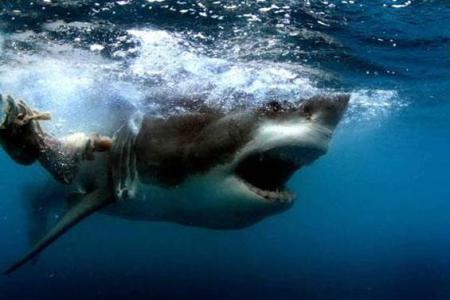High shark alert for Cape Town
Outrage is growing amongst the coastal communities of South Africa as it becomes more apparant that human interaction off shore is attracting sharks to popular swimming and surfing beaches.
Jeffreys Bay and St Francis Bay experienced numerous sightings of Great White Sharks close to shore that led to the unprecedented closing of Main Beach in December, and Fish Hoek has all but become a no go zone in recent times.
One of the common demoninators is chumming/baiting close to shore. And the problem may even get worse.
According to Dr. Dirk Schmidt, National Geographic is filming its reality show “Shark-Men” between the 10th – 30th April 2012 in False Bay. A permit to operate in the bay has been provided by Dr. Alan Boyd, Director of Biodiversity and Coastal Research – Environmental Affairs, without consultation of the local community.
5 000 kg of Tuna has been loaded, which is to be used for baiting and chumming. The use of possible whale meat or blubber has not been denied. This is in stark contrast to the local shark cage diving operators, which are limited to a maximum of 25 Kg of fish products per day.
The operating procedure for the capture of Great Whites includes actively attracting sharks to the ship and its support vessels, for scientists to select an appropriate “research” shark, which is then hooked, tired and exhausted to present less danger to the fishing crew and researchers, loaded on a submersible platform and raised out of the water.
The shark remains on the platform for up to 20 minutes during which a number of tests are performed, including body cavity implants, blood sampling and a satellite tagging. After the various procedures are completed it is floated back into the water.
Whilst this is done under the ambit of “television research” with the blessing of Environmental Affairs and local researchers, serious concern arises from a number of issues.
The close proximity to Muizenberg, winds and currents may take the chum slick inshore. An increased number of White sharks may be attracted from outside the bay to the Seal Island area due to the active chumming operation over an extended period of time.
Captured sharks are exhausted, stressed and disorientated after their ordeal, some initial tracking data released of other areas, suggests that “post-surgery” sharks leave the immediate area. Due to Seal Island lying in a horseshoe shaped bay, sharks may end up near Muizenberg and other popular beaches.
This may lead to possible increased shark-human interactions. A sharp increase in the number of White Sharks may be noted during and after the filming has been completed, as these sharks, initially attracted by volumes of chum to the Seal Island area, find their way around the bay. The dispersal of a massive chum slick, given on-shore winds, may further increase the number of inshore sharks which cruise the chum slick in search of food.
Dr. Dirk Schmidt believes it to be prudent, and as a preventative measure, that a high shark alert is issued and maintained during, and for several days after, the filming activity. Unusual White Shark behavior and an increased presence and possible shark-human interaction or even attacks – cannot be excluded.
In the event of a shark attack, we need to question, who will be held accountable, Dr. Boyd for issuing the permit, National Geographic and Fisher productions for baiting and chumming, the researchers for supporting the project?
Concerns may be directed to the Director of Biodiversity and Coastal Research – Dr. Alan Boyd at email: ajboyd@environment.gov.za , or National Geographic tkelly@ngs.org, or dedelson@ngs.org



No comments:
Post a Comment
Thank you, for visiting The Helderberg Basin Blog